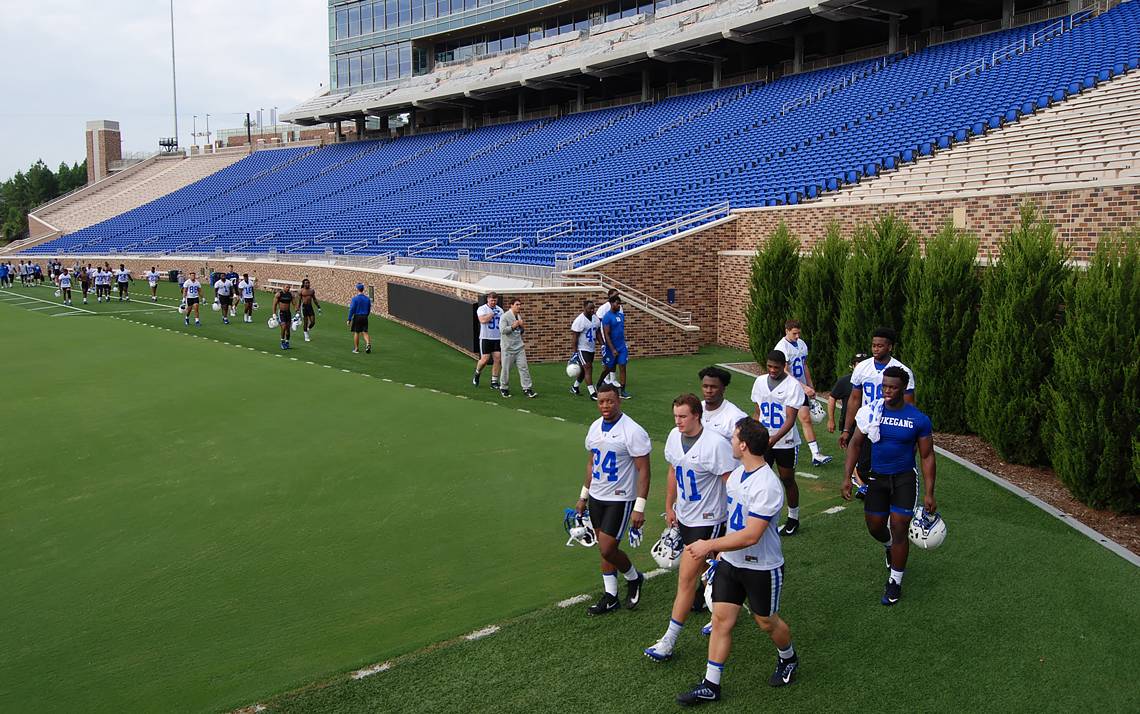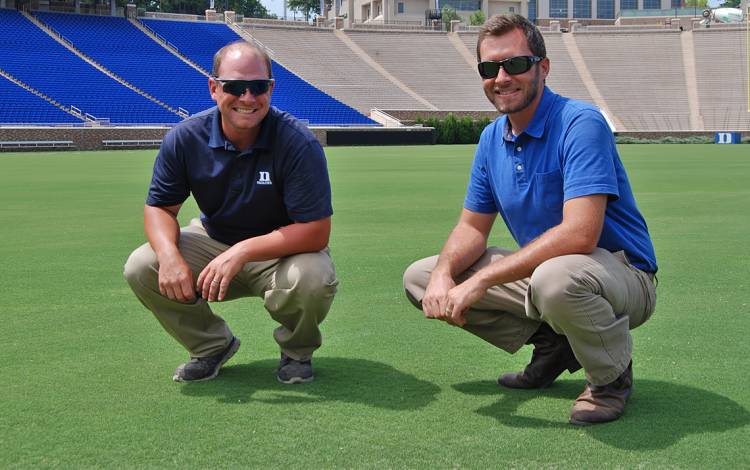Protecting Duke’s Home Turf
Groundskeepers use different approaches to keep the Blue Devils’ home fields pristine

Once on campus, new Duke football players see a video explaining the program’s ground rules.
Among the first is that, until told to, players don’t walk on the expanse of soft, green grass on the playing surface of Brooks Field at Wallace Wade Stadium.
“Whatever you do, don’t come anywhere near the grass,” said sophomore linebacker Koby Quansah. “It’s serious.”
 When reminded of the rule, Scott Thompson and Ian Christie simply grin. As two of the staff members charged with keeping the Blue Devils’ playing fields perfect, they appreciate the help.
When reminded of the rule, Scott Thompson and Ian Christie simply grin. As two of the staff members charged with keeping the Blue Devils’ playing fields perfect, they appreciate the help.
“The field is not just a little plot of grass anymore, it’s just as big a part of the stadium as anything else,” said Thompson, a grounds superintendent for Duke Facilities Management. “The stands, the tower, any of it.”
Taking care of Duke’s 11 athletic fields – four of them artificial – requires Duke Facilities Management’s landscape services team to have creativity, experience and trust. While the goal for every field is the same – firm, healthy grass that looks pretty, offers consistent footing and resists wear – the approaches to make that possible vary.
“Each field is different,” Thompson said. “The good part is, with our athletics administration and coaches, they know we’re going to do everything we can to give them the best possible product.”

Close shave
These days at Koskinen Stadium, home to Duke soccer and lacrosse, the field is covered in a rich, green Bermuda grass. Seeing it now, it’s hard to believe that in June it was bare dirt with a slight, green stubble.
On June 5, the field was fraze mowed. Done with a special machine, the process removes the top half-inch of the field, taking with it soil, decaying organic matter, weeds and tangles of roots that choke new growth.
“The theory is, you’re stripping out everything but you’re leaving the strongest plants,” said Christie, who heads an eight-member team that tends to Duke’s athletics venues. “What manages to survive is a strong viable entity. That’s what’s going to populate your field.”
This was necessary because, at 17 years old, Koskinen is the oldest of Duke’s playing fields. It’s also the only one that grows out of native soil – there’s no sandy substructure to aid drainage. So every few years, this procedure is required to allow the field to refresh itself.
The Duke Golf Club enjoyed a side benefit of the process. The grass and soil that was removed from Koskinen – which ended up being around 40 truckloads - was used to fill in bare patches on the club’s driving range.

Intentionally stressed
Duke’s newest playing field can be found in the softball stadium on East Campus. The first softball team in school history will open play on the field in the spring of 2018, which is good because the summer heat is giving the new field its first test.
While the grass on this field isn’t the same deep green as the others, there’s no reason to worry. This is all part of the plan.
Construction on the field began last fall with an 18-inch-deep base made of sand and organic material. The Latitude 36 Bermuda grass was planted in the spring. The first months weren’t easy. In an effort to strengthen roots, the grass was intentionally stressed by cutting it short and watering sparingly.
“If a grass is stressed, it fights to survive, it grows deeper roots to look for water,” Christie said. “You force it to survive.”
When softball season begins, the field will be lush and ready. And tough enough to handle whatever the Blue Devils throw at it.

Respect the grass
Right now, things are downright quiet on Wallace Wade Stadium’s Brooks Field.
As part of a recent stadium renovation, the old surface, which was surrounded by a track, was removed. The new field was built five feet lower than the previous one.
Since the end of last season – which saw the field hold up during a game played in a torrential downpour related to Hurricane Matthew – the field has only been used for the Blue Devils’ spring football showcase, May graduation and an occasional session of the Duke Football Camp.
During down time, Christie’s crew aerated the field to create room for roots to grow, and mowed it short to force the Latitude 36 Bermuda grass to grow sideways, creating a thick, dense layer of turf.
After a summer of meticulous maintenance, August, the final month of offseason, is when the field is left largely alone to fully grow into itself.
When the Blue Devils’ season kicks off Sept. 2, the field will be firm, fast and emerald green.
While the players can’t step foot on it now, when they finally do, the wait will be worth it.
“You just respect the grass, respect the work people do and stay off of it,” said linebacker Quansah. “When game time comes, you can go on there and do as much as you want.”